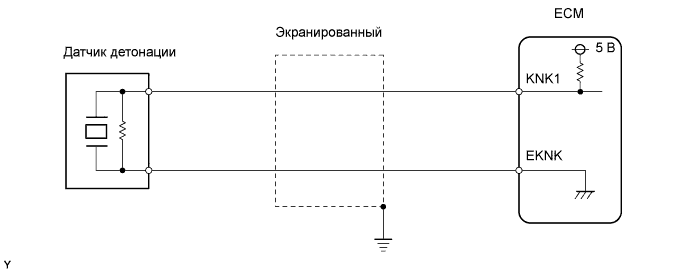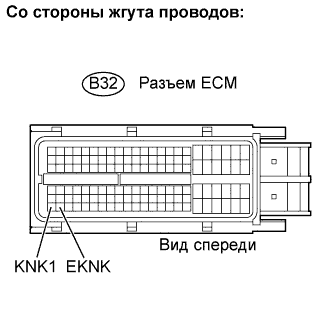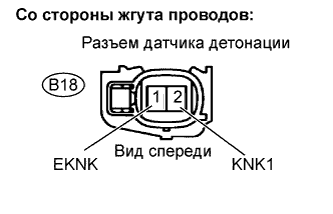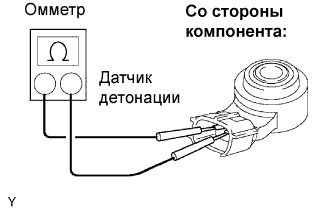Dtc P0327 Knock Sensor 1 Circuit Low Input (Bank 1 Or Single Sensor)
DESCRIPTION
WIRING DIAGRAM
INSPECTION PROCEDURE
READ VALUE OF INTELLIGENT TESTER (KNOCK FEEDBACK VALUE)
CHECK HARNESS AND CONNECTOR (ECM - KNOCK SENSOR)
INSPECT ECM (KNK1 VOLTAGE)
INSPECT KNOCK SENSOR
DTC P0327 Knock Sensor 1 Circuit Low Input (Bank 1 or Single Sensor) |
DTC P0328 Knock Sensor 1 Circuit High Input (Bank 1 or Single Sensor) |
DESCRIPTION
Flat type knock sensors (non-resonant type) have structures that can detect vibrations over a wide band of frequencies: between approximately 6 kHz and 15 kHz. A knock sensors are fitted onto the engine block to detect engine knocking.The knock sensor contains a piezoelectric element which generates a voltage when it becomes deformed.The voltage is generated when the engine block vibrates due to knocking. Any occurrence of engine knocking can be suppressed by delaying the ignition timing.DTC No.
| DTC Detection Condition
| Trouble Area
|
P0327
| Output voltage of knock sensor is 0.5 V or less
(1 trip detection logic)
| - Short in knock sensor circuit
- Knock sensor
- ECM
|
P0328
| Output voltage of knock sensor is 4.5 V or more
(1 trip detection logic)
| - Open in knock sensor circuit
- Knock sensor
- ECM
|
- УКАЗАНИЕ:
- When any of DTCs P0327 and P0328 are set, the ECM enters fail-safe mode. During fail-safe mode, the ignition timing is delayed to its maximum retardation. Fail-safe mode continues until the ignition switch is turned off.
Reference: Inspection using an oscilloscope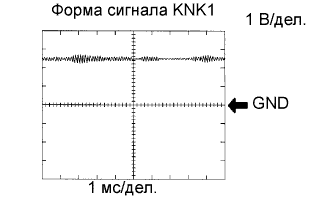 The correct waveform is as shown.
The correct waveform is as shown.Item
| Content
|
Terminals
| KNK1 - EKNK
|
Equipment Settings
| 1 V/DIV.
1 msec./DIV.
|
Conditions
| Keep engine speed at 4,000 rpm with warm engine
|
WIRING DIAGRAM
INSPECTION PROCEDURE
- УКАЗАНИЕ:
- Read freeze frame data using the intelligent tester. Freeze frame data records the engine conditions when malfunctions are detected. When troubleshooting, freeze frame data can help determine if the vehicle was moving or stationary, if the engine was warmed up or not, if the air-fuel ratio was lean or rich, and other data from the time the malfunction occurred.
| 1.READ VALUE OF INTELLIGENT TESTER (KNOCK FEEDBACK VALUE) |
Connect the intelligent tester to the DLC3.
Start the engine and turn the tester ON.
Warm up the engine.
Select the following menu items: Powertrain / Engine and ECT / Data List / Knock Feedback Value.
Read the values displayed on the tester while driving the vehicle.
- Standard:
- The values change.
- УКАЗАНИЕ:
Malfunction does not occur
| Knock Feedback Values change
|
Malfunctions occur
| Knock Feedback Values do not change
|
- The knock feedback value change can be confirmed by running the engine at high load, for example, by activating the air conditioning system and racing the engine.
| | CHECK FOR INTERMITTENT PROBLEMS |
|
|
| 2.CHECK HARNESS AND CONNECTOR (ECM - KNOCK SENSOR) |
Disconnect the B32 ECM connector.
Measure the resistance between the terminals.
- Standard resistance:
Tester Connection
| Specified Condition
|
KNK1 (B32-110) - EKNK (B32-111)
| 120 to 280 kΩ at 20°C (68°F)
|
Reconnect the ECM connector.
| 3.INSPECT ECM (KNK1 VOLTAGE) |
Disconnect the B18 knock sensor connector.
Turn the ignition switch on (IG).
Measure the voltage between the knock sensor terminals.
- Standard voltage:
Tester Connection
| Specified Condition
|
KNK1 (B18-2) - EKNK (B18-1)
| 4.5 to 5.5 V
|
Reconnect the knock sensor connector.
| OK |
|
|
|
| CHECK FOR INTERMITTENT PROBLEMS |
|
Remove the knock sensor.
Measure the resistance between the terminals.
- Standard resistance:
Tester Connection
| Specified Condition
|
KNK1 (2) - EKNK (1)
| 120 to 280 kΩ at 20°C (68°F)
|
Reinstall the knock sensor.
| OK |
|
|
|
| REPAIR OR REPLACE HARNESS OR CONNECTOR |
|

